In scrap car recycling, "incomplete shredding leading to difficult sorting", "equipment wear affecting production capacity", and "stepping on pitfalls in environmental compliance" are the most troublesome issues for practitioners. The process details of scrap car shredders (and supporting car machines) directly determine the efficiency and profit of recycling production lines. Below, we will break down the core technical logic of the equipment from principles to selection.
1. Operation Logic of Scrap Car Shredders: The Golden Process of "Pretreatment → Shredding → Resource Utilization"
A scrap car is a mixed solid waste of steel + plastic + rubber, and a shredder needs to meet the dual requirements of "shredding thoroughly + easy sorting" at the same time. Its process chain can be divided into:
1. Pretreatment: Disassemble First, Then Shred to Ensure Safety
A scrap car must first go through a disassembly line to remove components such as gasoline, airbags (flammable and explosive), waste engine oil, and lead-acid batteries (highly polluting), and only the car shell materials are sent to the shredder. This step is a prerequisite to prevent internal pollution of the equipment and avoid safety accidents.
2. Main Shredding: Controlling Particle Size through Graded Shredding is the Core
The shredder performs "coarse shredding → fine shredding" on the car shell:
◦ A hammer shredder smashes the car shell by the "impact + shearing force" of high-speed hammers; a roller shredder realizes shredding by double-roller extrusion and meshing.
◦ Finally, the particle size of the material is controlled within 2-8 inches (which can be adjusted according to downstream needs), which is convenient for subsequent sorting and avoids material waste due to "over-shredding".
3. Resource Utilization: Sorting After Shredding Determines Recycling Value
The shredded materials enter systems such as magnetic separation and eddy current separation to separate steel, non-ferrous metals, and plastics, and finally realize resource utilization such as "metal recycling and plastic regeneration", which is also the final value of the shredder process.
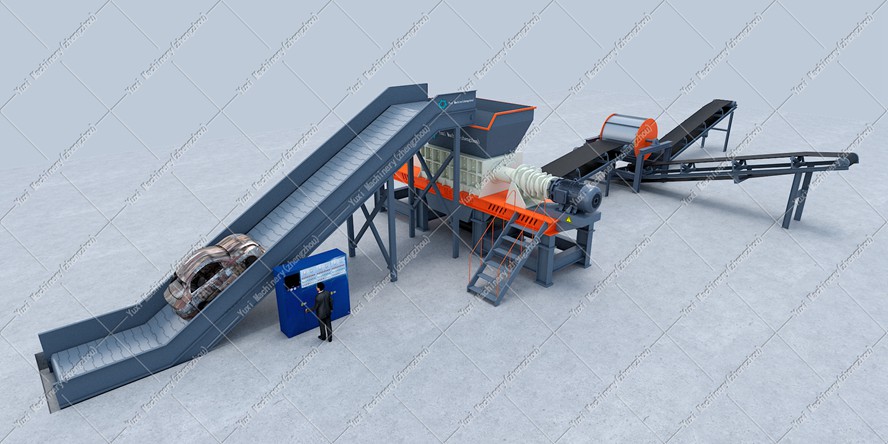
2. Core Configuration Details: Explaining Thoroughly from Three Dimensions of "Wear Resistance, Power, and Intelligence"
1. Wear-Resistant Components: "Hard Indicator" for Against High-Strength Car Shells
The frame of a scrap car often uses ASTM A572 high-strength steel, so the crushing chamber liner, hammers/rollers of the shredder must use high-wear-resistant materials:
• The material is AISI Mn13 high manganese steel or composite wear-resistant alloy. Some equipment uses "replaceable wear-resistant modules", which makes replacement more convenient and reduces maintenance costs.
• The size of the crushing chamber must match the car shell: the width of the feed port is at least 60 inches, and the inner cavity volume must be large enough to avoid the car shell being "jammed".
2. Power and Intelligent Control: Dual Guarantee of "Efficiency + Safety"
• Power: The motor power must be sufficient (in the range of 150-550HP, depending on the equipment model), and a hydraulic coupling or frequency conversion start must also be equipped to realize "soft start", otherwise it is easy to impact the power grid.
• Intelligence: A PLC control system is standard, which can view data such as current, speed, and cavity pressure in real time. If "unshreddable parts" fall into the cavity, the equipment will automatically reverse or stop to prevent the machine from being damaged.
3. Connection with Car Shredding Machines: "Coarse Shredding + Fine Shredding" Improves Efficiency
A car shredding machine is equivalent to a "front coarse shredder":
• It uses a double-shaft/four-shaft cutter set to tear the entire car shell into large pieces of 12-32 inches, making it easier for the shredder to "bite".
• For production lines that want to recycle rare metals, the combined process of first shredding and then shredding can make subsequent sorting more accurate and reduce material waste.
3. Processing Technology and Component Details: Professional Disassembly from "Steel to Finished Product"
1. Shell and Main Shaft: "Firmness + Precision" are Indispensable
• The shell is welded with thickened ASTM A36 steel plate, and it must be reinforced inside, otherwise it is easy to deform and leak material during high-strength shredding.
• The main shaft must use forgings, and must also go through quenching and tempering, rust-proof treatment. During processing, steps such as "blanking → quenching and tempering → drilling → grinding" must not be missed to ensure strength and precision.
2. Cutter System: "Material + Process" Determine Shredding Force
• The cutter material can be AISI H13, SKD11, etc. (high hardness and wear resistance), and it must go through more than ten processes such as surfacing, forging, and polishing during processing to ensure that it is both sharp and durable.
• Some equipment is equipped with a water cooling device, which can cool the cutters and transmission parts and prolong their service life.
3. Bearings: "Spherical Roller Bearings" to Deal with High Torque
The shredder works at "low speed and high torque", so spherical roller bearings must be used - its outer ring has a spherical raceway, which can automatically adjust the angle error between the shaft and the bearing seat to prevent the machine from being damaged due to inclination.
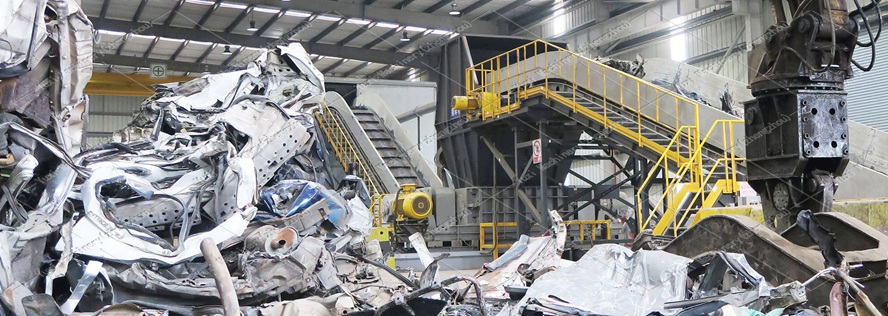
4. Selection and Compliance Points: "Select According to Needs + Operate in Compliance"
1. Selection: Matching Scale and Materials is the Core
• Processing scale:
◦ Small recycling plants (annual processing < 20,000 tons): choose a shredder with 10-20 short tons per hour;
◦ Large bases: choose 40-100 short tons per hour (for example, the YXS-1600 model can process 26-39 short tons per hour).
• Material characteristics:
◦ Only shred disassembled car shells (with few impurities): choose a simple-structured hammer machine;
◦ Shred whole cars with a small amount of impurities: a composite machine with impurity removal function must be selected.
• Environmental protection: A pulse bag dust collector must be equipped to collect dust, and the noise must meet local standards (such as the US EPA noise standard). If necessary, a sound insulation cover should be added.
2. Equipment Parameter Reference (YXS Series as an Example, Units Adapted to Overseas Habits)
| Model | Power (HP) | Processing Capacity per Hour (Short Tons) | Material Size (Inches) | Hopper Size (Inches) | Equipment Weight (Pounds) | Overall Dimensions (Inches) |
| YXS-600 | 200×2 | 4-6 | 12-40 | 32×36 | 5,500 | 104×80×76 |
| YXS-800 | 300×2 | 6-10 | 12-40 | 36×40 | 7,900 | 112×80×76 |
| YXS-1000 | 500×2 | 10-18 | 12-40 | 48×40 | 12,600 | 120×80×76 |
| YXS-1200 | 600×2 | 13-22 | 12-40 | 56×40 | 20,900 | 128×80×76 |
| YXS-1600 | 1000×2 | 26-39 | 12-40 | 92×80 | 52,900 | 200×120×96 |
3. Compliance and Trends: "Abide by Regulations + Follow Trends" to Avoid Pitfalls
• Compliance: Scrap car recycling belongs to hazardous waste treatment, and the production line must comply with local regulations (such as the US RCRA or EU ELV directive).
• Trend: Now, production lines of "intelligent sorting + shredder" are popular. For example, an AI visual sorting system is used to automatically identify different materials in the car shell, making sorting more efficient.
5. FAQ: 3 Most Concerned Questions of Practitioners
1. "Can the shredder shred other scrap metals?"
Yes, but it depends on whether the strength and size of the scrap metal are within the design range of the equipment (such as scrap steel, waste home appliance shells). However, it should be noted that different materials must be set with separate shredding parameters, otherwise it is easy to damage the machine.
2. "How long can wearing parts such as hammers be used?"
It depends on the material and processing volume. When shredding scrap car shells, AISI Mn13 hammers can generally be used for 1,500-4,000 hours; if the shredded material has few impurities and low strength, it can be used for more than 5,000 hours.
3. "What do small recycling plants need to prepare in the early stage of investing in a shredder?"
Three steps:
◦ Handle qualifications: Obtain compliance qualifications for scrap car recycling and hazardous waste treatment;
◦ Plan the site: Reserve space for pretreatment, shredding, and sorting, and also equip dust removal and noise reduction facilities;
◦ Select equipment: Find a manufacturer to select a model according to your own scale and materials (it is recommended to buy small-sized or second-hand equipment first to test the water).
6. Conclusion: Choose the Right Equipment to Improve Both "Efficiency + Profit" in Scrap Car Recycling
The technical details of scrap car shredders directly affect the development efficiency of "urban minerals". Whether you are an experienced practitioner who wants to upgrade the production line or a novice who has just entered the industry, you must carefully select equipment from the dimensions of wear resistance, power, and intelligence. It is best to visit the actual production line of the equipment manufacturer before deciding to cooperate. After all, only when the equipment is selected correctly can the recycling business be operated more smoothly and profitably.
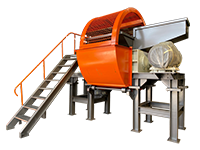 Shredding Machine
Shredding Machine
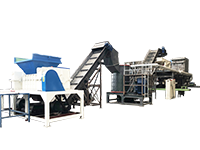 Waste Recycling Line
Waste Recycling Line
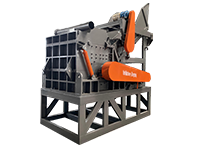 Optional Equipment
Optional Equipment


